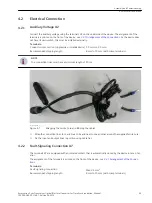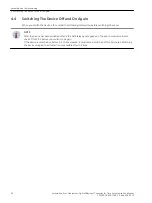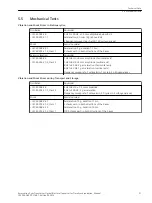
Device Data
Supply Voltage
Auxiliary voltage – direct voltage
DC 24 V to 250 V (± 20 %)
Permissible ripple of the DC input voltage
15 %
Power consumption
3 W
Maximum inrush current at ≤ 110 V
< 15 A
Maximum inrush current at 220 V to 300 V
≤ 22 A
After 250 μs: < 5 A
Efficiency level
> 50 % at rated load
Auxiliary voltage – alternating voltage
AC 60 V to 230 V (± 20 %) at 45 Hz to 65 Hz
Permissible higher harmonics
2 kHz
Maximum inrush current at ≤ 115 V
< 15 A
Maximum inrush current at 230 V
≤ 22 A
After 250 μs: < 5 A
Power consumption
7 VA
Power-failure backup
Min. 50 ms at rated load
Output-voltage status display
1 green LED to display the operating state
Fault-Signaling Connection (Relay)
Relay
Standard relay, 1 break contact, isolated; 2-pole
terminal
Maximum contact voltage with a resistive load
AC 240 V
Maximum switching current
5 A
Maximum switching power
AC 2000 VA
Permissible current for contacts
5 A
Test voltage
V
RMS
= 3.51 kV
Electronic Load Disconnecting Relay (K2)
Binary outputs (OPTOMOS)
DC 24 VDC to 250 V; +15 %/-20 %
Permissible current for contacts
100 mA
Minimum switching current
1 mA
Maximum switching power
Maximum 250 mW average internal power dissipa-
tion; dependent on the switching frequency
Test voltage
V
RMS
= 3.51 kV
Binary Input BI 2
Binary input
DC 24 V to 250 V; +15 %/-20 %
Switch threshold value
Can be switched using the jumper X100:
– Approx. 17 V with jumper position 1‑2
– Approx. 70 V with jumper position 2‑3
Input current
< 5 mA
Pickup time
Approx. 5 ms
5.1
Technical Data
5.1 Device Data
46
Accessories, Sync Transceiver, Optical/Electrical Converter for Time Synchronization, Manual
C53000-G9050-C168-1, Edition 09.2019











































